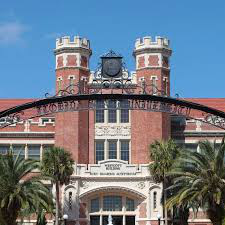Speaker
Description
We investigate 𝑆=−1 and −2 hypernuclei with 𝐴=4−7 employing the Jacobi-NCSM approach [1] and in combination with baryon-baryon (BB) interactions derived within the frame work of chiral effective field theory. The employed BB interactions are softened using the so-called similarity renormalization group (SRG) [2] in order to speed up the convergence. Such a SRG evolution is only approximately unitary when the SRG induced higher-body forces are omitted. Impact of the SRG evolution and of the two almost phase-equivalent YN NLO13 [3] and NLO19 [4] potentials on the $\Lambda$ separation energies of 𝐴=4−7 hypernuclei is thoroughly studied [5]. Finally, we report our recent results for $\Xi$ hypernuclei based on the chiral NLO $\Xi N$ potentials [6]. We found three shallow bound states for the $NNN \Xi$ system while the $^5_{\Xi}\mathrm{H}$ and $^7_{\Xi}\mathrm{H}$ are more tightly bound [7].
[1] P. Navratil, G. P. Kamuntavicius, and B.R. Barrett, Phys. Rev. C61, 044001 (2000).
[2] S. K. Bogner, R. J. Furnstahl, and R. J. Perry, Phys. Rev. C 75, 061001 (2007).
[3] J. Haidenbauer and others Nucl. Phys. A 915, 24 (2013).
[4] J. Haidenbauer, U.-G. Meißner, and A. Nogga, Eur. Phys. J. A 56, 91 (2020).
[5] H. Le, J. Haidenbauer, U.-G. Meißner, and A. Nogga, Eur. Phys. J. A 56, 301 (2020).
[6] J. Haidenbauer and U.-G. Meißner, Eur. Phys. J. A 55, 23 (2019).
[7] H. Le, J. Haidenbauer, U.-G. Meißner, and A. Nogga, Eur. Phys. J. A 57, 339 (2021).
| speaker affiliation | Forschungszentrum Juelich |
|---|

